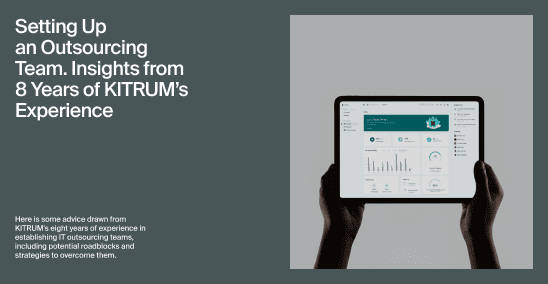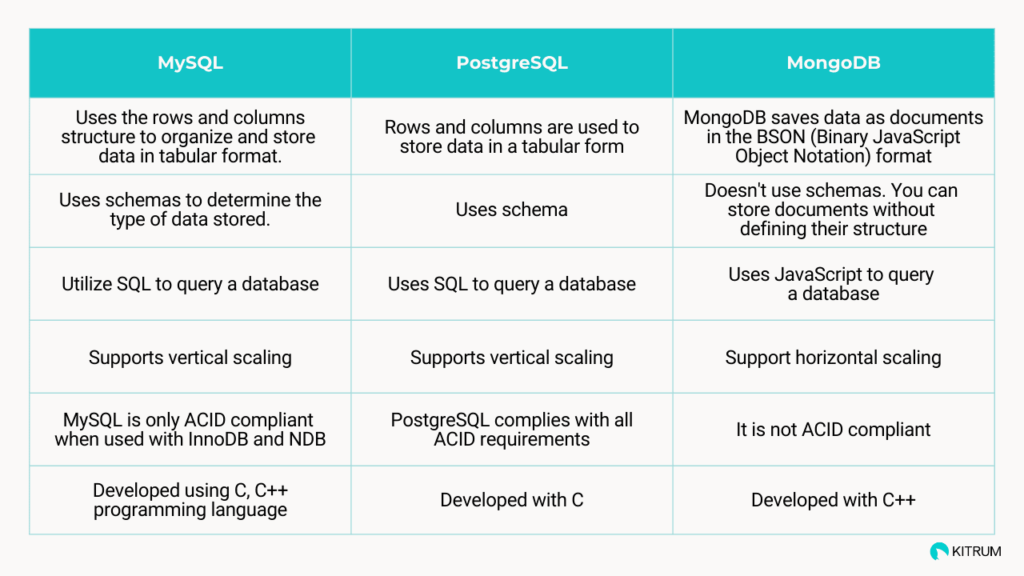Your business today grapples with diverse data management challenges, such as handling large data volumes, ensuring data integrity, and supporting real-time applications. And you probably know that selecting the right DBMS (Database Management System) is pivotal to meeting these specific needs. But how to choose the right database? The large variety of DBMS options has certainly spoiled businesses for choice. In a recently compiled list of most and not all DBMS, we counted 52 of them, 10 of which are pretty popular.
Before diving in, let’s break down what a DBMS is in simple terms, especially for non-developers and our friends new to the tech scene.
What is DBMS?
Think of your business as a big office with tons of paperwork: customer information, sales records, inventory details, and more. Managing all this data manually would be chaotic and time-consuming. But with a DBMS, it’s like having a dedicated team of filing experts.
The DBMS stores and organizes your data neatly, making it easy to access whenever you need it. It keeps track of customer orders, manages employee records, and ensures your inventory is up to date. Just like a well-organized filing system, a DBMS helps your business run smoothly and efficiently. It’s your behind-the-scenes data superhero, making sure everything is in its right place and ready for action.

This brings us to the crux of the discussion: a comparison of 3 very popular DBMSs you are familiar with – MySQL, PostgreSQL, and MongoDB.
So, you probably have a lot of questions: is PostgreSQL better than MySQL? Or is MySQL better than MongoDB? Well, we are not going to tell you which is better because, realistically, neither is ultimately better than the other; they just all have their strengths and weaknesses. However, selecting the right DBMS isn’t just a technical decision; it’s a strategic one. The choice you make shapes the trajectory of your business, influencing everything from daily operations to long-term scalability.
MySQL
In today’s big data world, MySQL is one of the most well-known database technologies. It is frequently referred to as the most widely used database. This year, MySQL still remains a top choice, competing with PostgreSQL (which we will discuss below). It secures the second position, with 41.09% of developers opting for it. Interestingly, last year, MySQL held the first position.
MySQL is designed to be open-source and has a vast and active community. It was built using the C and C++ programming languages. It is compatible with various operating systems, including Linux, OS X, Solaris, and Windows. Many prominent companies across diverse industries rely on MySQL for their data management needs. These include industry leaders like Airbnb, Sony, BBC, YouTube, Spotify, GitHub, and countless others.
Benefits of MySQL
Open-source and free
MySQL is open-source, and of course, we know that open-source programs with an active community have the advantage of continuous development and updates. Also, the DBMS has a community version available for free installation. However, the free version doesn’t have as many features as the paid ones, but it is still efficient for smaller projects.
Simple and flexible
The architecture and operations of MySQL are pretty simple. Thanks to better security, it ensures comprehensive operations, even for large-volume projects. Debugging can also be done more quickly.
Good performance
MySQL’s most recent version was created with speed and efficiency. Even for E-commerce websites, the database is quite promising due to its high performance and good memory cache. It can address multiple (up to a million) requests at once.
Wide compatibility
Despite its popularity as a database for web applications, MySQL was created to work with a wide range of technologies and systems. The RDBMS is compatible with various computing platforms, including Unix-based operating systems like Linux, Mac OS, and Windows.

Drawbacks to MySQL
Limited open-source activity
Although MySQL is an acclaimed open-source database, it no longer seems that way in practice. Since coming under Oracle’s control, MySQL now has private closed-source modules. Open-source developers are getting disenchanted with the project because of Oracle’s Purported development stumbling blocks and refusal to disclose test cases for defects and security updates.
SQL standards are not completely followed
MySQL’s departure from strict adherence to SQL standards may pose challenges for your business, particularly if your operations rely heavily on standardized SQL syntax. In such cases, it can lead to compatibility issues when migrating from or integrating with systems that adhere more closely to SQL standards. This non-compliance may require additional development efforts to ensure seamless data handling and querying within your business applications.
PostgreSQL
PostgreSQL is another popular DBMS that shares a lot of similarities with MySQL. Do people still use PostgreSQL? Well, the answer is definitely yes. This year, PostgreSQL moved into the top spot, surpassing MySQL. According to the most recent survey, 45.55% of developers prefer PostgreSQL.
PostgreSQL is a relational database management system (DBMS) that creates more complex data structures by combining defined objects and table procedures. Its goal is to improve the adherence and expansibility of the standards. As a result, it can handle any workload, whether for a single machine or a complicated application.
It was developed as an open-source DBMS. This DBMS was created using the C programming language and is compatible with Microsoft, iOS, Android, NetBSD, Linux, and other platforms. Do big companies use PostgreSQL? Well, as ClutchInfo reports, major players like Apple, social media giant Instagram, and popular site Reddit are all part of the PostgreSQL user community. Now, let’s have a look at the benefits and drawbacks of PostgreSQL.
Benefits of PostgreSQL
Enhanced scalability
PostgreSQL is optimized for quick and continuous scalability, and this quality gives it an edge over MySQL. Because of its high scalability capabilities, PostgreSQL can be deployed in large corporations and for high-demanding projects.
100% open-source
PostgreSQL has the best and most active open-source ideology. It offers organizational efficiency and limitless growth opportunities. Users of PostgreSQL can also participate actively in the community by posting and sharing bugs and problems.
Comprehensive support for custom data
PostgreSQL is popularly known to have good operational support for NoSQL data modules. It supports a wide range of data types, including JSON, XML, H-Store, etc., by default. This gives your business unparalleled flexibility in managing diverse data structures. This versatility enables your organization to efficiently handle complex data requirements, making it an excellent choice if your business needs to work with various data formats, ensuring adaptability and agility in a rapidly evolving data landscape.
Collaborate efficiently with other tools
There is a wide range of database management tools that complement DBMS. Unfortunately, many DBMSs have limited integration ability. PostgreSQL solves this problem by integrating effortlessly and efficiently with many other independent tools.
Drawbacks to PostgreSQL
Quite slow
People who use Postgres run into a variety of performance concerns as well as backup recovery issues. Frequently, you’ll have a slow query and see that your database environment’s performance has degraded. Due to its relational database structure, Postgres must start with the first row and then scan through the entire table to identify the relevant data while looking for a query. As a result, it’s slower, especially when there’s a lot of data in the rows and columns of a table with many variables to compare.
Incomplete documentation
Even though PostgreSQL has a big community and offers excellent assistance, the documentation remains irregular and incomplete. Due to the scattered nature of the PostgreSQL community, documentation for all Postgre features adheres to different standards.
There are no reporting or auditing tools
There is a higher chance that engineers would miss PostgreSQL failure due to the lack of auditing tools. Using this tool requires carefulness.
Can PostgreSQL replace MySQL?
Yes, PostgreSQL can replace MySQL in some cases, but it depends on what your business needs. Both are powerful database systems, but if your business needs advanced features, supports complex data types like JSON and XML, and manages transactions carefully, PostgreSQL could be a good choice. However, switching from MySQL to PostgreSQL can be a bit tricky, as they use different commands and rules. So, you need to check if your applications work well with PostgreSQL and plan the switch carefully based on your specific database needs.
MongoDB
MongoDB is a non-relational data storage management system that processes and stores large amounts and varying data types using flexible documents rather than tables and rows. MongoDB does not require a relational data storage system because it is a NoSQL solution; hence, it offers an extensible data storage format that allows you to manage multiple data types easily.
MongoDB is developed and managed by MongoDB.Inc, which was first released in February 2009. According to the most recent survey, MongoDB is the choice of 25% of all developers. It is widely used because it offers flexibility by supporting all popular programming languages. According to ClutchInfo, some notable companies use MongoDB, including Verizon, Adobe, Buffer, Beet, and Acxiom. So, what are pros and cons of MongoDB?
Benefits of MongoDB
Operational efficiency
The rapid and simple operations are one of MongoDB’s advantages gained from its Non-SQL nature, allowing your business to handle high-throughput workloads efficiently. Data can be instantly inputted, saved, and retrieved from the database without the need for further validation. It prioritizes RAM utilization so records can be accessed quickly without compromising data quality, all of which are critical for maintaining customer satisfaction and competitive advantage.
Support for multiple languages
MongoDB’s multi-language support is one of its best features. MongoDB has been updated through several versions and is still being developed, with driver support for prominent programming languages such as Python, PHP, Ruby, C++, Scala, JavaScript, etc.
Interoperability with various data formats
MongoDB’s ability to work seamlessly with various data formats, including SQL and NoSQL, is a significant advantage for your business. This interoperability ensures that your data can be efficiently integrated and used across different platforms and systems, promoting flexibility and enhancing data-driven decision-making processes.
Drawback of MongoDB
Requires a large amount of memory space
The operations of MongoDB require a lot of memory space for efficiency. This DBMS also remembers the key names for each value pair, contributing to its memory consumption.
Interpreting into different query languages is a complicated process
Because MongoDB was not designed to execute relational data models from the start, performance may suffer in these situations. Furthermore, converting SQL to MongoDB queries requires additional steps to use the engine, potentially causing delays.
Nesting space is limited
The limitation on nesting space in MongoDB, which restricts nesting documents to fewer than 100 levels, can pose challenges for your business. This limitation may hinder the ability to represent complex data structures or relationships within your applications, potentially leading to data modeling difficulties and complicating the development of certain features or functionalities. It’s essential to consider these limitations when designing your data storage strategy to ensure scalability and flexibility for your business applications.
MongoDB vs MySQL. Can MongoDB replace MySQL?
Yes, MongoDB can replace MySQL in certain situations, depending on your business requirements. When evaluating database options, understanding the difference between MongoDB and MySQL is crucial to choosing the solution for your specific data management needs.
MongoDB is a NoSQL database, which means it’s particularly suited for handling unstructured or semi-structured data, making it a great choice for businesses with data types like JSON. However, if your business relies heavily on structured data and needs strong ACID (Atomicity, Consistency, Isolation, Durability) transaction support, MySQL might be a better fit. Switching from MySQL to MongoDB requires careful consideration and adaptation of your applications to work effectively with MongoDB’s document-oriented data model. So, it’s crucial to assess your specific database needs before making a switch.
PostgreSQL vs MySQL vs MongoDB
Now, let’s delve into a detailed comparison of MongoDB vs PostgreSQL vs MySQL in the table below to help you make an informed decision for your specific business needs.

Conclusion
In this article, we’ve delved into Database Management Systems (DBMS) and explored 3 most popular options: MySQL, PostgreSQL, and MongoDB. These DBMSs offer unique strengths and, of course, possess some weaknesses. Remember, choosing the right DBMS is a pivotal decision for your business, as it can significantly impact daily operations, scalability, and long-term success. The diverse options available mean that there’s a solution tailored to every unique need.
If you’re unsure which DBMS suits your business best, KITRUM is here to help. Our team of experts can provide personalized advice and solutions to ensure your data management aligns perfectly with your business goals.







